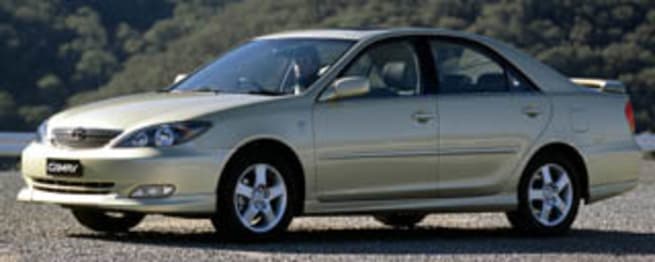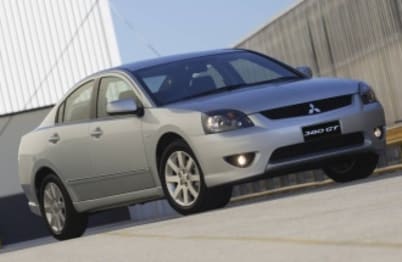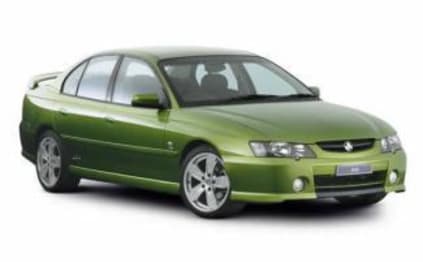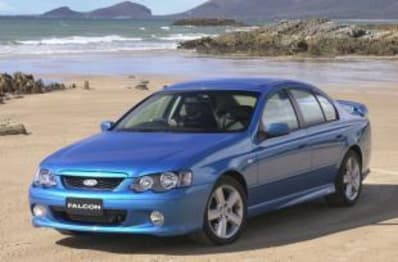
Used Toyota Camry review: 2002-2006
- Toyota Camry
- Toyota Camry 2004
- Toyota Camry 2005
- Toyota Camry 2006
- Toyota Camry 2002
- Toyota Camry 2003
- Toyota Camry Reviews
- Toyota Reviews
- Toyota Sedan Range
- Sedan
- Toyota
- Used Car Reviews

What we like
- Reliability
- Parts availability
- V6 power
What we don't
- Bland design
What we like
- Reliability
- Parts availability
- V6 power
What we don't
- Bland design
The Camry has long struggled to gain any real traction with Australian families, most of whom dismissed it as bland and boring as they passed the Toyota showroom on their way to buy a sexier Commodore or Falcon.
But there were others, particularly companies and government departments that saw Toyota's locally built mid-sized front-wheel drive car as a more sensible choice.
As fuel prices began to soar the four-cylinder Camry became particularly appealing.
Models
By 2002, when the new fifth generation Camry was released, the old wide-bodied model was well dated, and by contrast the new model's trim lines were much more pleasing.
Gone from the range was the wagon, the new model only available as a four-door sedan, but there was a good choice of models, and the option of four-cylinder or V6 engines.

The range was made up (in ascending order of equipment) of the Altise, Ateva, Sportivo, which were all available with the four-cylinder engine, and the V6. In addition, there was the fully kitted-out Azura and Grande, which only came with the V6.
As the entry-level model the Altise had the shortest list of features, but it still included air conditioning, four-speaker stereo sound with a CD player, a tacho, remote central locking, power windows and mirrors, and remote releases for the boot and fuel filler.
The option list was made up of ABS brakes, cruise control, sat nav and metallic paint.
Next in line was the Ateva, which had a longer list of standard features that added six-speaker sound, a tilt-adjustable steering column, cruise, a trip computer, engine immobiliser, alloy wheels, and woodgrain cabin highlights to the mix.

For more, the option list offered front side airbags, sat nav and an electric sunroof.
If you wanted a sporty drive there was the Sportivo, which came standard with 16-inch alloy wheels, sports suspension, a sports body kit, sports seats, sports instruments, a leather-clad steering wheel and gear knob, metallic paint, fog lamps, cruise, climate control air conditioning, in-dash CD stacker, variable intermittent wipers, an alarm, and front side airbags.
You could also have sat nav and an electric sunroof, but they were options.
The Azura V6 was the ultimate sports ride in the range; it came with everything the Sportivo featured, and no options.
It was fitted standard with leather trim, a sports steering wheel, trip computer, woodgrain in the dash, doors and centre console, sat nav and a sunroof.
If you wanted a more refined ride there was the Grande V6, which like the Azura came with everything, except the sports gear.

There was more leather, chrome and woodgrain, the driver's seat was powered, there was an illuminated vanity mirror, a rear blind, map and reading lamps, anti-glare rear view mirror, rear armrest, and audio controls were on the steering wheel.
Bluetooth wasn't a feature on any of the models so you couldn't sync your iPhone or Android device, there was no touch screen, no parking sensors, no reversing camera, and no park assist.
Cabin
Thanks to its larger body – it was 35 mm longer, 10 mm wider, and 70 mm taller than the old model – the cabin was roomier.
Front and rear headroom were increased over the outgoing car, and rear seat legroom grew by a massive 98mm.

The seats were comfortable and quite supportive, and passengers sat relatively upright, which yielded good all-around vision and made it easier to get in and out.
Functional best described the Camry's cabin; the controls were easy to operate, although the handbrake lever on the left side of the centre console was awkward.
Along with the roomier cabin the boot was also generous, it was 10 per cent larger than the old model, and the split fold rear seat made it even more capacious.
All but the Altise had cupholders in the front and rear.
Engine
The locally built 2.4-litre four-cylinder petrol engine was a step up in capacity from the 2.2-litre engine of the preceding model.

It featured all-alloy construction and twin camshafts, with Toyota's VVTi variable valve timing system on the intake valves, and at its twin peaks it put out 112kW (150 horsepower) and 218Nm of torque.
With 18kW and 31Nm more than the old engine it was a willing and free-revving workhorse that delivered pretty decent performance, and better fuel economy.
For more performance Toyota offered the 3.0-litre petrol V6, which upped the peak power and torque to 141kW (189 horsepower) and 279Nm respectively, giving it more zip and extra smoothness.
The gearbox options were a conventional four-speed automatic transmission and a five-speed manual. Most buyers preferred the automatic, so there aren't many cars around with the manual.
Both engines were developed to run on 91-octane regular unleaded, and can also run on E10 ethanol-blend fuel.
Driving
Toyota put a lot of effort into developing the Camry for Australian roads and conditions, tweaking the suspension, brakes, seats, and headlights.

The Sportivo, with its firmer suspension and sporty tyres, delivered the more rewarding driving experience Toyota's engineers were aiming for, but the rest of the range was still set up more for comfort than handling.
Inside, it was quiet and refined, with little road noise, but there was some harshness from the four-cylinder engine when under hard acceleration.
With the four-cylinder the Camry struggled a little under the weight of its heavier body, but it came alive with the V6 with its excellent mid-range performance.
Safety
The list of safety features was quite comprehensive for the time this model was released, but it lacked many of the safety items expected in a car of today.
As the entry level the Altise had front airbags for the driver and front seat passenger, lap sash seat belts front and rear, and seat belt pretensioners in the front seats, but ABS was an extra cost option.

The rest of the models in the range were better equipped, ABS brakes were standard, and they also had front side airbags.
Lap sash seat belts in the rear allowed the fitment of a baby car seat, but it was too early for ISOFIX child restraint location points.
ANCAP rated this Camry at four stars.
Any common issues
Toyota has a well-earned reputation for reliability, and the fifth generation Camry is no exception.
There are no serious issues for the used car buyer to be concerned about, but with some cars having done as many as 250,000km-plus the problems found are more likely to be due to normal wear and tear.

Sun damage to interior plastic parts is a complaint that occasionally crops up; peeling paint is another to watch out for.
Look for oil leaks around the engine, and check for smoke from the tailpipe, particularly under acceleration, which could indicate engine wear.
Similarly, look for oil leaks around the gearbox/automatic transmission.
It's important for long engine life that the oil is regularly changed, which makes it crucial that a car has a service record showing regular maintenance.

While owners are usually conscious of the need to change engine oil, they rarely consider the automatic transmission, which should also be serviced to maintain its long-term health.
Servicing the automatic transmission is even more important if a car has been used for towing.
If the transmission is noisy, or is reluctant to shift, or shifts sharply, walk away, you could be in for an expensive rebuild.
Toyota didn't introduce capped price servicing to the Camry until 2016, so it doesn't apply to this model. But the service costs are generally reasonable and any local mechanic should be able to do the required work.
The four-cylinder engine has a timing chain, so doesn't need replacing, but the V6 has a belt, which Toyota recommends changing every 150,000km.

A couple of recalls affect the Camry; one in 2011 for the headlight switch, which was prone to corrosion and could cause the headlamps to flicker or go out; there was another in 2011 for a possible problem with the crankshaft damper.
When new the warranty was for three years/100,000km, but that has long since expired.
MORE: If anything crops up, you'll probably find it on our Toyota Camry problems page
Owner's views
Alan Singleton: I bought my four-cylinder Altise second hand in 2013 with 60,000km on the odometer, and to date it's been very reliable and economical.
Mil Hanna: My Ateva V6 is powerful and roomy, and it has never let me down. But at 16.0L/100km around town the fuel consumption isn't great.
Peter Taylor: I bought my 2004 four-cylinder Altise in 2016. At 160,000km the engine and transmission are like new, but I have had to make a number of small repairs. I still think it's great.
Phil Williams: The 2005 Sportivo I bought in 2015 is a great car. It's got 215,000km and I have had no problem with it at all.
Jake Legge: I've never been happy with my 2002 Sportivo four-cylinder, it's always pulled to the left and the engine is gutless.
Verdict
Not a bad buy if your budget limits you to an older car.
Specifications
Built: Australia
Body: Four door sedan
Models: Altise, Ateva, Sportivo, Azura, Grande
Seats: Five
Engine: 2.4-litre four-cyl, 112kW/218Nm 3.0-litre V6, 141kW/279Nm
Gearbox: Five-speed manual, Four-speed auto
Drive: Front-wheel drive
0-100km/h: 9.3s (2.4), 8.3s (V6)
Fuel consumption: 8.8-9.8L/100km (2.4), 9.9-11.2L/100km (V6)
Fuel: 91-octane unleaded petrol
Fuel tank capacity: 70 litres
Oil: 5W-30
Front suspension: MacPherson strut independent
Rear suspension: multi-link independent
Turning circle: 11.2m
Safety rating: Four-star ANCAP
Spare: full size
Kerb weight: 1390-1540 kg
Towing capacity: (2.4) 500kg (trailer without brakes), 1200kg (trailer with brakes); (V6) 500kg (trailer without brakes), 1600kg (trailer with brakes)
Ground clearance: 147mm
Do you run an early noughties Camry? Tell us about your ownership experience in the comments below.
Pricing
| Year | Price From | Price To |
|---|---|---|
| 2006 | $3,300 | $8,140 |
| 2005 | $3,080 | $8,030 |
| 2004 | $3,080 | $7,590 |
| 2003 | $3,080 | $7,590 |
| 2002 | $2,640 | $7,590 |
Pricing guides
Range and Specs
| Vehicle | Specs | Price* | |
|---|---|---|---|
| CSi | 2.2L, ULP, 5 SP MAN | $2,640 – 4,070 | 2002 Toyota Camry 2002 CSi Pricing and Specs |
| Advantage | 3.0L, ULP, 5 SP MAN | $3,080 – 4,730 | 2002 Toyota Camry 2002 Advantage Pricing and Specs |
| CSi | 2.2L, ULP, 4 SP AUTO | $3,080 – 4,840 | 2002 Toyota Camry 2002 CSi Pricing and Specs |
| Conquest | 2.2L, ULP, 4 SP AUTO | $3,190 – 4,950 | 2002 Toyota Camry 2002 Conquest Pricing and Specs |
Other cars to consider
$2,750
Lowest price, based on 37 car listings in the last 6 months











